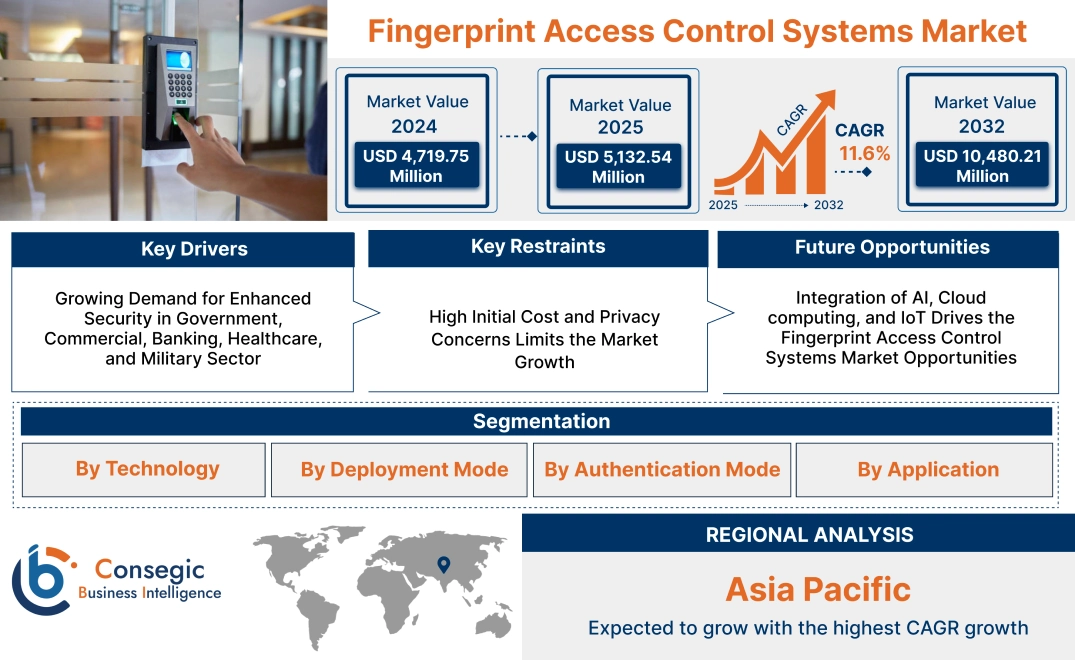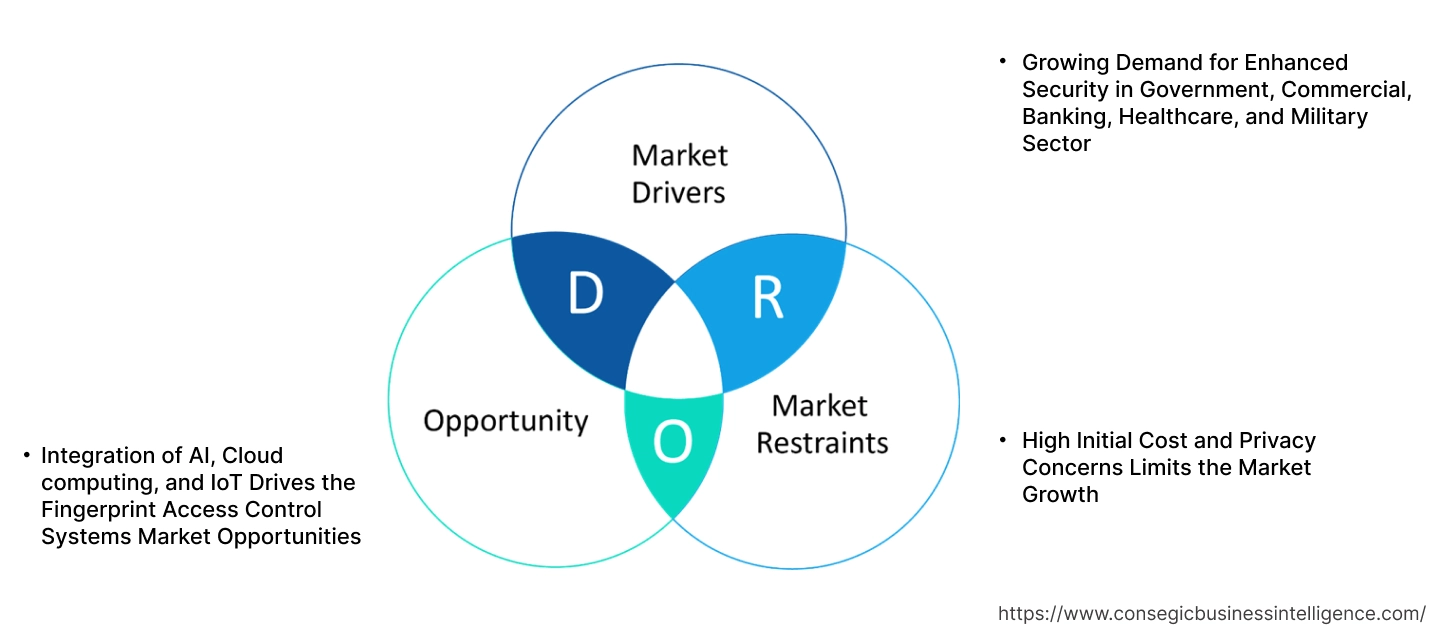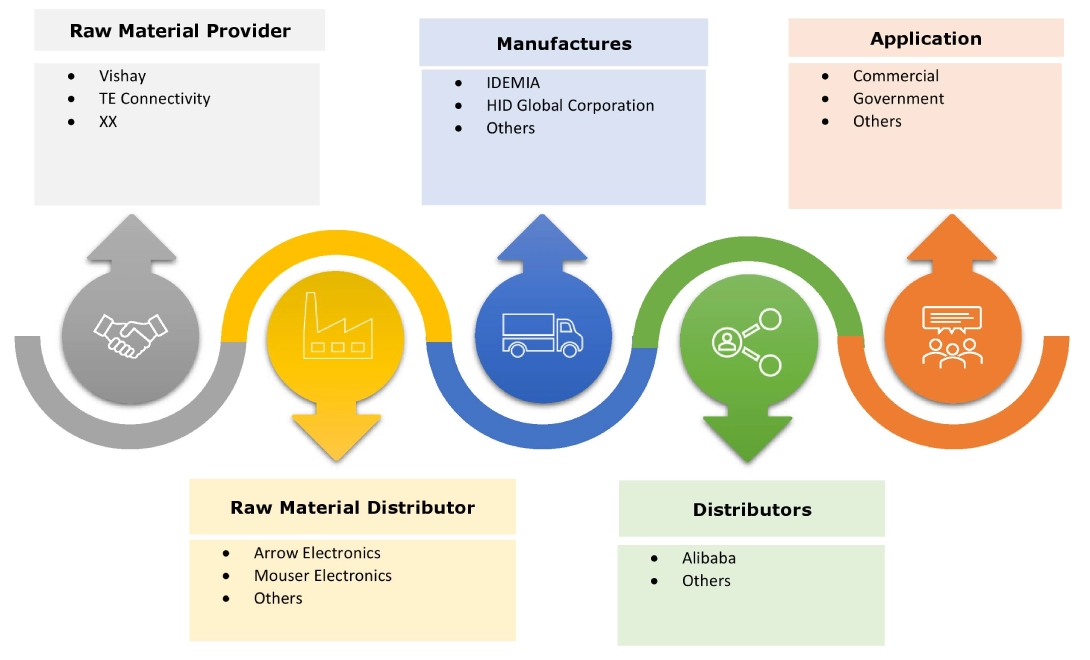- Summary
- Table Of Content
- Methodology
Fingerprint Access Control Systems Market Size:
Fingerprint Access Control Systems Market Size is estimated to reach over USD 10,480.21 Million by 2032 from a value of USD 4,719.75 Million in 2024 and is projected to grow by USD 5,132.54 Million in 2025, growing at a CAGR of 11.6% from 2025 to 2032.
Fingerprint Access Control Systems Market Scope & Overview:
Fingerprint access control systems are security solutions that use an individual's unique fingerprint to verify their identity and grant or restrict access to specific areas or resources. The benefits including enhanced security, keyless entry, fast and efficient access and cost-effectiveness are driving the market growth. Moreover the system finds application in a wide range of sectors including commercial, consumer electronics, government, military & defense, banking & finance, healthcare, and others. The key trends driving the market include increasing demand for heightened security measures and rapid advancements in biometric technology. Additionally, the growing adoption of multi-factor authentication and the need for contactless solutions are significantly contributing to the market.
Key Drivers:
Growing Demand for Enhanced Security in Government, Commercial, Banking, Healthcare, and Military Sector
The rising need for robust security measures across critical industry like government, commercial, banking, healthcare, and military is a primary catalyst for the fingerprint access control systems market's expansion. These sectors handle sensitive data, valuable assets, and critical infrastructure, which necessitates the need for stringent security protocols. In government sector, fingerprint systems secure sensitive information and control access to restricted areas while commercial enterprises prioritize employee and asset protection. Further, the healthcare facilities protect patient records, and military utilizes these systems for secure access to bases and classified information.
- For instance, in March 2023, IDEMIA has launched two new contactless biometric devices, OneLook Gen2 and MorphoWave TP, at the Passenger Terminal EXPO 2023. OneLook Gen2 enhances facial and iris capture for faster and more accurate identity verification, ideal for border control and smart boarding. MorphoWave TP provides contactless, on-the-move ten-fingerprint capture, improving processing at various borders.
Thus, adoption of fingerprint access control systems across a wide range of sectors drives the market.
Key Restraints:
High Initial Cost and Privacy Concerns Limits the Market Growth
The widespread adoption of fingerprint access control systems faces limitations due to high initial implementation costs and significant privacy concerns. The expense of advanced biometric hardware, software integration, and ongoing maintenance creates a barrier, particularly for smaller organizations. Additionally, the collection and storage of sensitive biometric data raise concerns about potential misuse, unauthorized access, and data breaches. The privacy concerns deter individuals and organizations from embracing fingerprint access control thereby slowing down market growth.
Future Opportunities :
Integration of AI, Cloud computing, and IoT Drives the Fingerprint Access Control Systems Market Opportunities
The convergence of Artificial Intelligence (AI), cloud computing, and the Internet of Things (IoT) is significantly expanding the potential of fingerprint access control systems. AI enhances accuracy and speed by enabling advanced pattern recognition and real-time analysis of biometric data. Cloud computing facilitates centralized data storage and remote management, allowing for scalable and flexible access control solutions. Further, IoT integration connects fingerprint systems to a network of devices, enabling seamless data sharing and automation. This synergy allows for the development of intelligent security systems that can adapt to evolving threats, provide real-time monitoring, and offer enhanced user convenience. For instance, AI can improve the accuracy of the fingerprint readings, while cloud computing allows for the data to be securely stored and accessed remotely. Thus, integration of AI, cloud computing, and IoT drives the fingerprint access control systems market opportunities.
Fingerprint Access Control Systems Market Segmental Analysis :
By Technology:
Based on the technology, the market is segmented optical, capacitive, pressure, ultrasonic, thermal, and others.
Trends in the Technology:
- Increasing emphasis on capturing detailed 3D fingerprint data for enhanced security and accuracy is driving the fingerprint access control systems market trend.
- Growing improvements in sensor design to minimize the impact of ambient temperature and humidity is expected to drive fingerprint access control systems market size.
Optical accounted for the largest revenue share in the market in 2024.
- Increasing development of optical scanners that can capture fingerprint images without physically touching the device, increasing hygiene and usability in turn driving the fingerprint access control systems market share.
- Further, use of higher-resolution sensors for more detailed and accurate fingerprint capture drives the market.
- Furthermore, rising focus on preventing spoofing with advanced techniques to detect fake fingerprints is driving the market.
- Thus, as per fingerprint access control systems market analysis, enhanced detection, improved image resolution, and contactless optical scanning are driving the fingerprint access control systems market size.
Capacitive is anticipated to register the fastest CAGR during the forecast period.
- Increasing adoption of capacitive sensors integrated beneath smartphone and other devices is driving the fingerprint access control systems market share.
- Further, continued efforts to reduce sensor size and power consumption for integration into smaller devices is expected to drive the fingerprint access control systems market demand.
- Furthermore, improvements in sensor materials and design to increase resistance to scratches, wear, and environmental factors are driving the market.
- Therefore, under-display integration, miniaturization & power efficiency, and enhanced durability is anticipated to boost the market during the forecast period.
By Deployment Mode:
Based on the deployment mode type, the market is segmented into on-premises, cloud-based, and hybrid.
Trends in the Deployment Mode:
- The growing focus on creating hybrid solutions that balance the security of on-premises systems with the flexibility of cloud-based solutions which in turn drives the fingerprint access control systems market demand.
- Increasing emphasis on providing highly scalable and flexible solutions that can adapt to changing organizational needs.
On-premises accounted for the largest revenue share of 57.94% in the year 2024.
- Growing emphasis on seamless integration of fingerprint technology with existing security systems and building management systems is boosting the market.
- Further, growing demand for highly customizable solutions that provide organizations with complete control over their access control systems is driving the fingerprint access control systems industry.
- Thus, as per fingerprint access control systems market analysis, integration with existing infrastructure and customization are driving the market.
Cloud-based is anticipated to register the fastest CAGR during the forecast period.
- The increased focus on mobile apps and platforms for remote access management and monitoring propels the market.
- Further, integration of AI and machine learning for advanced analytics, threat detection, and predictive maintenance is a key factor in the rise of fingerprint access control systems market trends.
- Therefore, mobile access and management and ai-powered analytics is anticipated to boost the market during the forecast period.
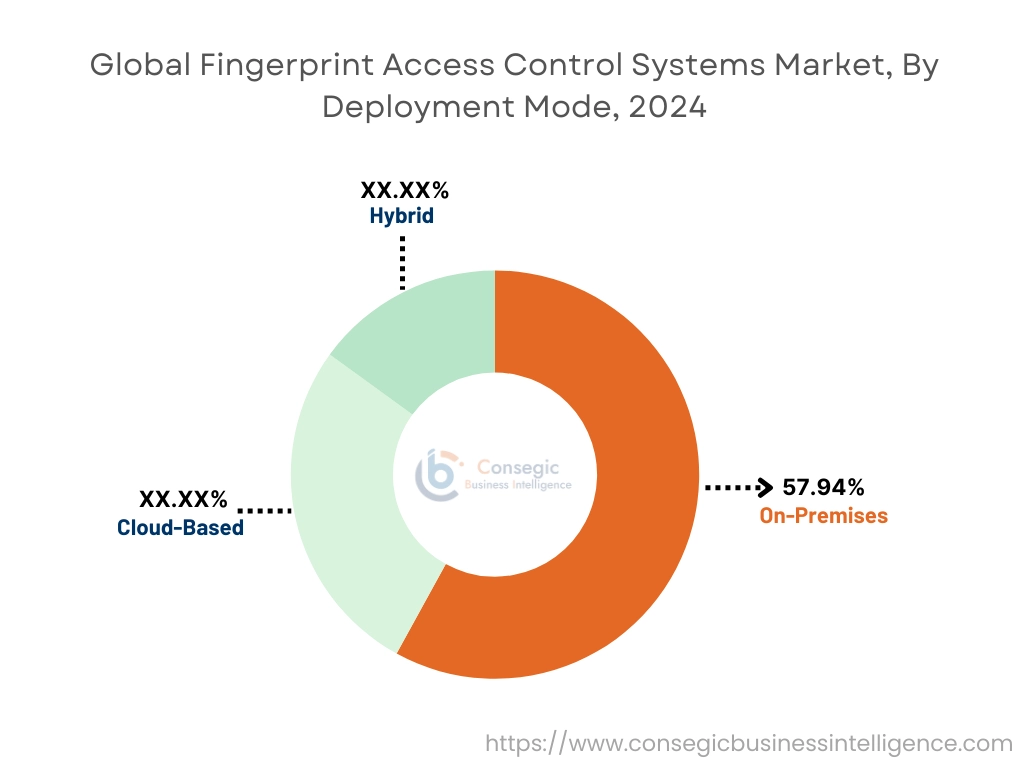
By Authentication Mode:
Based on the authentication mode, the market is segmented into single factor authentication and multi factor authentication.
Trends in the Authentication Mode:
- There's a significant shift towards password-less authentication, where biometrics (fingerprint and facial recognition) replaces traditional password which in turn drives the fingerprint access control systems market expansion.
Single factor authentication accounted for the largest revenue share in the year 2024.
- Single-factor biometric authentication, such as fingerprint or facial recognition, is becoming more prevalent due to its convenience which in turn drives the market.
- Further, growing commercial sector across the globe is driving fingerprint access control systems market growth.
- Thus, based on analysis, growing commercial sector and convenience is driving the market.
Multi factor authentication is anticipated to register the fastest CAGR during the forecast period.
- Growing integration of next generation biometrics technologies which include fingerprint, facial recognition, and others as one or more factors for multi factor authentication which in turn propels the fingerprint access control systems market expansion.
- Further, incorporating behavioral biometrics as a passive authentication factor is adding an extra layer of security.
- Furthermore, utilization of blockchain and decentralized identity solutions to provide users with greater control over their authentication is accelerating the market growth.
- Therefore, based on analysis, the aforementioned trends are expected to boost the market during the forecast period.
By Application:
Based on the application, the market is segmented into commercial, consumer electronics, government, military & defense, banking & finance, healthcare, and others.
Trends in the Application:
- Rising use of fingerprint scanners to accurately identify patients and grant authorized personnel access to electronic health which in turn drives the market.
- Increasing use of scanners in factories and industrial facilities to control access to hazardous areas and secure equipment which in turn drives the market.
Commercial accounted for the largest revenue share in the year 2024.
- The growing integration of fingerprint access control wi th other building systems, such as HVAC, lighting, and security cameras, for centralized management which in turn drives the market.
- Further, there is growing demand for touchless fingerprint solutions to improve hygiene and reduce the spread of germs which drives the market.
- Furthermore, fingerprint systems are being used to accurately track employee attendance, reducing fraud, and improving payroll accuracy which in turn drives the market.
- For instance, in December 2024, IDEMIA Smart Identity's Biometric Recognition System (IBRS), a multimodal biometrics identification service, has achieved Open Standards Identity API (OSIA) Qualified status.
- Thus, based on analysis, integration of fingerprint access control with other building systems, improved hygiene, and attendance is driving the market.
Banking & finance is anticipated to register the fastest CAGR during the forecast period.
- Fingerprint authentication is used for secure logins to online banking platforms and mobile apps, enhancing transaction security which in turn is driving propels the fingerprint access control systems market.
- Further, scanners are being deployed at ATMs and bank branches to prevent unauthorized access and protect against fraud which is a key factor in the fingerprint access control systems market trends.
- Furthermore, banks are using fingerprint systems to control access to vaults, data centers, and other secure areas, limiting access to authorized personnel.
- Therefore, based on analysis, aforementioned factors are anticipated to boost the market during the forecast period.
Regional Analysis:
The regions covered are North America, Europe, Asia Pacific, Middle East and Africa, and Latin America.
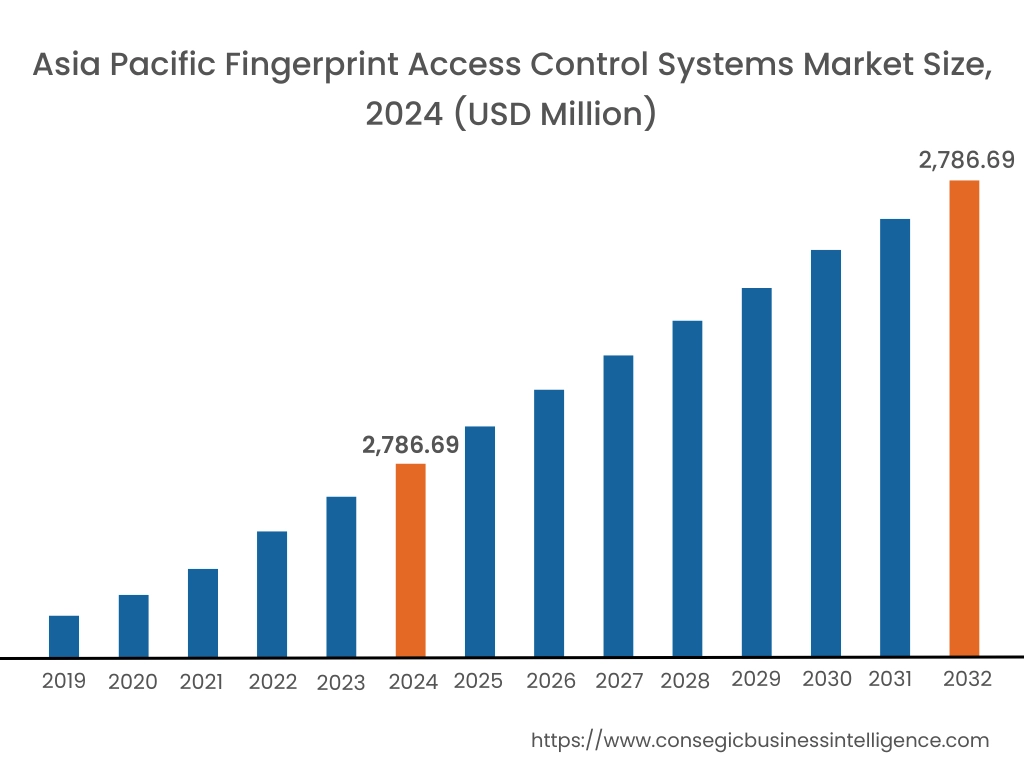
Asia Pacific region was valued at USD 1,214.93 Million in 2024. Moreover, it is projected to grow by USD 1,324.81 Million in 2025 and reach over USD 2,786.69 Million by 2032. Out of this, China accounted for the maximum revenue share of 30.27%. The market for fingerprint access control systems is mainly driven by rapid urbanization and increasing government initiatives focused on enhancing public safety and security through biometric identification. Additionally, the region's expanding consumer electronics sector and the rising adoption of smart technologies contribute significantly to market growth.
- For instance, Matrix Comsec offers COSEC PATH Readers which supports multiple credentials (fingerprint, RFID), secure communication (SSL encryption), and tamper detection. Its IP65 rating allows for outdoor use, and it integrates seamlessly with controllers.
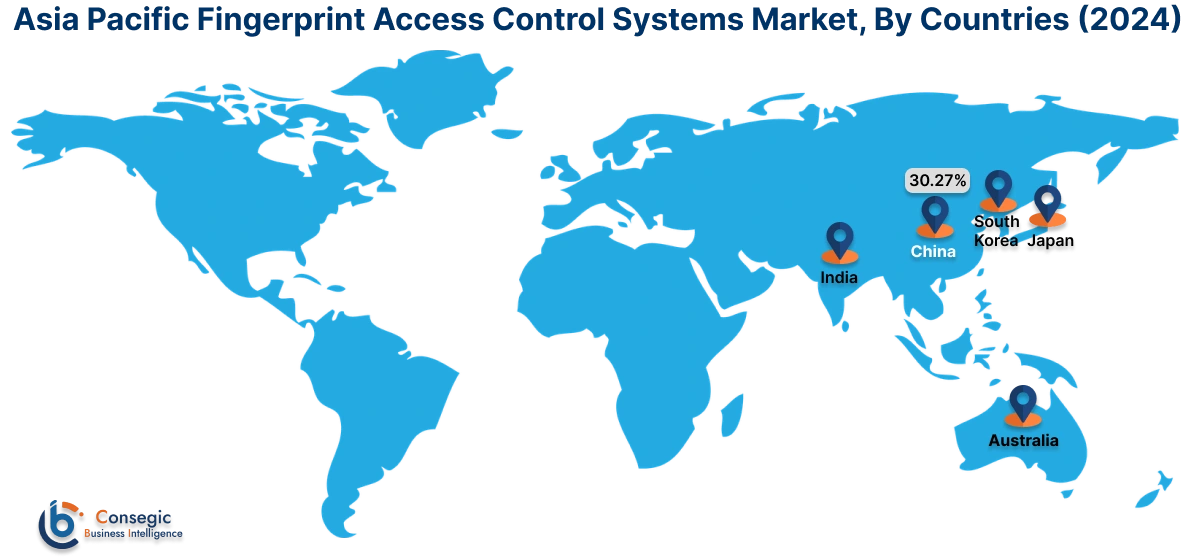
North America is estimated to reach over USD 3,667.03 Million by 2032 from a value of USD 1,668.89 Million in 2024 and is projected to grow by USD 1,813.27 Million in 2025. The North American market is primarily driven by growing security concerns across various sectors, including commercial, government, and healthcare. Furthermore, the rising adoption of advanced technologies and increasing regulatory compliance is accelerating the market growth.
- For instance, in June 2023, IDEMIA Identity and Security (I&S) North America launched IDent 2.0, a handheld biometric device, to enable law enforcement to perform rapid, real-time suspect identification in the field. The technology enhances officer safety and operational efficiency by providing immediate access to criminal history and warrant information.
The regional analysis depicts that stringent data protection regulations and a strong emphasis on enhancing security across both public and private sector in Europe is driving the market. Additionally, the factors driving the market in the Middle East and African region are increasing government investments in security infrastructure and a rising demand for advanced security solutions in the banking, hospitality, and oil & gas sectors. Further, increasing security concerns and the growing adoption of biometric technologies for government identification and commercial security are paving the way for the progress of market in Latin America region.
Top Key Players and Market Share Insights:
The global fingerprint access control systems market is highly competitive with major players providing solutions to the national and international markets. Key players are adopting several strategies in research and development (R&D), product innovation, and end-user launches to hold a strong position in the fingerprint access control systems industry. Key players in the global fingerprint access control systems market include-
- IDEMIA (France)
- Bosch Sicherheitssysteme GmbH (Germany)
- NEC Corporation (Japan)
- Suprema Inc. (South Korea)
- UNIONCOMMUNITY Co., Ltd (South Korea)
- HID Global Corporation (US)
- Hitachi Ltd. (Japan)
- Johnson Controls Inc. (US)
- Lockheed Martin Corporation (US)
- Aware, Inc. (US)
- Matrix Comsec (India)
Recent Industry Developments :
Product Launch:
- In January 2025, IDEMIA launched a new smartphone-based fingerprint enrollment solution for biometric payment cards, aiming to simplify and accelerate user onboarding. This innovation uses a USB-C dongle and a smartphone app to guide users through the enrollment process, offering a more user-friendly alternative to existing methods.
Merger and Acquisition:
- In January 2025, HID Corporation acquired 3millID Corporation and Third Millennium Systems Ltd. to expand its physical access control portfolio. The acquisition brings new readers and credentials to HID's offerings and strengthens its presence outside the U.S. 3millID is a North American provider of access control readers, while Third Millennium, based in Wales, serves the UK and Europe.
Fingerprint Access Control Systems Market Report Insights :
| Report Attributes | Report Details |
| Study Timeline | 2019-2032 |
| Market Size in 2032 | USD 10,480.21 Million |
| CAGR (2025-2032) | 11.6% |
| By Technology |
|
| By Deployment Mode |
|
| By Authentication Mode |
|
| By Application |
|
| By Region |
|
| Key Players |
|
| North America | U.S. Canada Mexico |
| Europe | U.K. Germany France Spain Italy Russia Benelux Rest of Europe |
| APAC | China South Korea Japan India Australia ASEAN Rest of Asia-Pacific |
| Middle East and Africa | GCC Turkey South Africa Rest of MEA |
| LATAM | Brazil Argentina Chile Rest of LATAM |
| Report Coverage |
|
Key Questions Answered in the Report
How big is the fingerprint access control systems market? +
The fingerprint access control systems market is estimated to reach over USD 10,480.21 Million by 2032 from a value of USD 4,719.75 Million in 2024 and is projected to grow by USD 5,132.54 Million in 2025, growing at a CAGR of 11.6% from 2025 to 2032.
What specific segmentation details are covered in the fingerprint access control systems report? +
The fingerprint access control systems report includes specific segmentation details for technology, deployment mode, authentication mode, application, and regions.
Which is the fastest segment anticipated to impact the market growth? +
In the fingerprint access control systems market, multi factor authentication is the fastest-growing segment during the forecast period.
Who are the major players in the fingerprint access control systems market? +
The key participants in the fingerprint access control systems market are IDEMIA (France), Bosch Sicherheitssysteme GmbH (Germany), HID Global Corporation (US), Hitachi Ltd. (Japan), Johnson Controls Inc. (US), Lockheed Martin Corporation (US), Matrix Comsec (India), NEC Corporation (Japan), Suprema Inc. (South Korea), UNIONCOMMUNITY Co., Ltd (South Korea), Aware, Inc. (US) and others.
What are the key trends in the fingerprint access control systems market? +
The fingerprint access control systems market is being shaped by several key trends including the increasing integration of AI and cloud-based solutions for enhanced security and the growing demand for multi-factor authentication.
